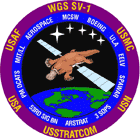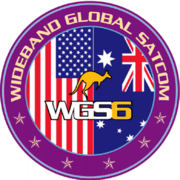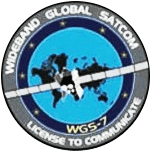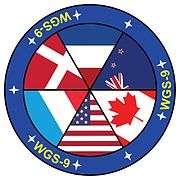Wideband Global SATCOM
The Wideband Global SATCOM system (WGS) is a high capacity satellite communications system planned for use in partnership by the United States Department of Defense (DoD), Canadian Department of National Defence (DND) and the Australian Department of Defence.[1] The system is composed of the Space Segment satellites, the Terminal Segment users and the Control Segment operators.[2]
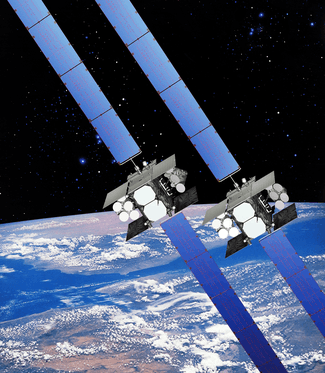
DoD wideband satellite communication services are currently provided by a combination of the existing Defense Satellite Communications System (DSCS) and Global Broadcast Service (GBS) satellites.[3] According to United Launch Alliance, quoted on Spaceflight Now, "A single WGS spacecraft has as much bandwidth as the entire existing DSCS constellation."[4] WGS operations are currently run by the 4th Space Operations Squadron, out of Schriever Air Force Base, as well as the 53d Signal Battalion out of Fort Carson, CO.
Mission
The constellation of WGS satellites increases the communications capabilities of the militaries of the United States, Canada, and Australia by providing additional bandwidth and communications capabilities for tactical command and control, communications, and computers; intelligence, surveillance, and reconnaissance (C4ISR); battle management; and combat support information. Canada has also signed on to become a partner.[5]
WGS also augments the current Ka-band Global Broadcast Service (on UHF F/O satellites) by providing additional information broadcast capabilities as well as providing new two-way capability on that band. It provides services to the US DoD and Australian Department of Defence. The IWS System supports continuous 24-hour-per-day wideband satellite services to tactical users and some fixed infrastructure users. Limited protected services will be provided under conditions of stress to selected users employing terrestrial modems capable of providing protection against jamming.
Capabilities
The WGS satellites will complement the DSCS III Service Life Enhancement Program (SLEP) and GBS payloads and will offset the eventual decline in DSCS III capability. WGS will offer 4.875 GHz of instantaneous switchable bandwidth, thus each WGS can supply more than 10 times the capacity of a DSCS III Service Life Enhancement Program (SLEP) satellite. Once the full constellation of 6 WGS satellites is operational, they will replace the DSCS system. WGS-1 with its 2.4 Gbit/s wideband capacity, provided greater capability and bandwidth than all the DSCS satellites combined.[6]
Segments
Operation and usage of the system is broken into 3 segments.
The end users of the communication services provided by the WGS are described by the DoD as the terminal segment. Users include the Australian Defence Force and U.S. Army ground mobile terminals, U.S. Navy ships and submarines, national command authorities for the nuclear forces, and various national security/allied national forces. Additionally, the Air Force Satellite Control Network will also use the WGS in a similar manner as the DSCS III constellation is used to route ATM packets through the DISA "cloud" to establish command and control streams with various satellite constellations. One of the emerging applications is SATCOM-ON-The-Move which is now being extensively used on the military tactical vehicles for Blue Force Tracking and C3 missions.
The satellite operators in charge of commanding and monitoring the satellite's bus and payload systems as well as managing the network operating over the satellite are the control segment. Like the DSCS constellation that WGS will replace, spacecraft bus will be commanded by the 4th Space Operations Squadron of Schriever AFB, Colorado. Payload commanding and network control is handled by the Army 53rd Signal Battalion headquartered at nearby Peterson AFB, Colorado with subordinate elements A Co. at Fort Detrick, Maryland, B Co. at Fort Meade, Maryland, E Co. at Fort Buckner, Okinawa Japan, C Co. Landstuhl Germany, and, D Co. Wahiawa, Hawaii.
The primary contractor for the satellites themselves is Boeing Satellite Development Center, which is building them around the Boeing 702 satellite platform. Originally five satellites were planned. On 3 October 2007, Australia's Department of Defence announced that the country would fund a sixth satellite in the constellation.[7] Once in their orbits at an altitude of 22,300 mi (35,900 km), each will weigh approximately 7,600 lb (3,400 kg). The program intends to use both the Delta IV and the Atlas V as launch vehicles. The Air Force Space Command estimates each satellite will cost approximately US$300 million.
The first three WGS satellites form Block I of the space segment. The next three, WGS satellites 4, 5, and 6, make up Block II.[8] The next four, WGS 7, 8, 9, and 10, make up Block II Follow-On.
Launches
Block I
The first launch (WGS-1) was conducted by United Launch Alliance (ULA) on 1 10 October 2007. The satellite was carried by an Atlas V (421) lifting off from LC-41 at Cape Canaveral Air Force Station (CCAFS). After launch, the WGS-1 satellite was given the US military designation USA-195. Its coverage area stretches from the U.S. western coast to Southeast Asia.[9]
Launch of the second satellite (WGS-2) was also conducted by ULA, at 01:31 UTC on 4 April 2009, using an Atlas V 421. A ULA Delta IV flying from LC-37B at CCAFS launched the third spacecraft on 6 December 2009. The WGS-2 satellite was positioned over the equator around 60° East longitude (over the Indian Ocean) for use by U.S. Central Command in Afghanistan, Iraq and other parts of Southwest Asia.[9][10] Originally, the second spacecraft was to fly on the Delta, and the third on the Atlas, but they were switched for an undisclosed reason.[11]
WGS-3 was launched on 6 December 2009, covers the eastern Atlantic Ocean.[12] The satellite was launched by a Delta IV "Medium+ (5,4)" rocket (originally Atlas V but switched with WGS-2; see above).
Block II
WGS-4, the first of the Block II, was launched by United Launch Alliance from SLC-37B at the Cape Canaveral Air Force Station by a Delta IV Medium+ (5,4) on 20 January 2012, 00:38 AM UTC.[13]
WGS-5 was successfully launched by a Delta IV rocket flying in the Medium+(5,4) configuration, with lift-off taking place from SLC-37B in Florida at 20:27 local time on 24 May 2013.[14]
In May 2013, Boeing reported that the WGS-6 satellite had been shipped to Florida,[15] WGS-6 was launched on a Delta IV rocket at 20:29 EDT (00:29 GMT) on 7 August 2013 from Cape Canaveral Airforce Base.[16]
These satellites represent the Block II WGS satellites.[9][17]
Block II Follow-On
On 23 August 2010, Boeing was awarded an Air Force contract worth $182 million to begin work on the seventh WGS satellite. The new spacecraft was procured under the WGS Block II follow-on contract which included options for production of up to six WGS satellites.[8]
WGS-7 was successfully launched by a Delta IV rocket, with lift-off taking place from Complex 37 in Florida at 0007 GMT (20:07 local time) on 24 July 2015.[18]
WGS-8 was successfully launched by a Delta IV Medium+ (5,4) rocket on 7 December 2016 at 2353 GMT (6:53 p.m. EST) from SLC-37B at Cape Canaveral Air Force Station in Florida. The Delta IV's Delta Cryogenic Second Stage deployed the satellite as planned at 0035 GMT on 8 December 2016 (7 December 2016 7:35 p.m. EST).[19][20]
WGS-9 was launched on 18 March 2017. It was launched on a Delta IV launch vehicle. The satellite was partially-funded by allied nations, including Canada, for military access to the entire WGS constellation [21]
WGS-10 was launched atop a Delta IV rocket from Cape Canaveral Air Force Station on 15 March 2019.[22] WGS-10 is the latest part of a constellation of highly-capable communications satellites that serve the armed forces of the United States and its allies. It carries Ka-band and X-band transponders with 8.088 gigahertz of bandwidth – offering downlink speeds of up to 11 gigabits per second.
In 2019, Boeing received a contract to build an 11th WGS satellite. WGS-11 is to be completed by Boeing by 20 November 2023 under a $605 million contract.[23][24]
See also
References
- "Australia Gets Access to Wideband Global SATCOM System". deagel.com. 14 November 2007. Retrieved 16 August 2020.
- "Wideband Global SATCOM Satellite". U.S. Air Force Space Command. Archived from the original on 8 January 2007.
- "Environmental Assessment - U.S. Air Force Wideband Gapfiller Satellite Program". Defense Technical Information Center.
- "Pre-launch ops keep crews busy at the Cape". Spaceflight Now.
- "Canada's Participation in the Wideband Global Satellite Communications System". forces.gc.ca. Government of Canada. 17 January 2012. Retrieved 9 October 2018.
- "Wideband Gapfiller System". GlobalSecurity.org.
- "Australia To Fund Sixth WGS Satellite". Satellite Today.
- "Boeing Awarded Follow-on Contract for Seventh WGS Satellite. WGS-7, a "Block-II Follow On" was launched on July 23, 2015". Advantecon Web Site. Advantecon. 23 August 2010. Retrieved 23 August 2010.
- "Delta 4 assigned to deliver military satellite into orbit". Spaceflight Now. 4 January 2010.
- "Atlas 5 rocket successfully launches military satellite". Spaceflight Now.
- "Military communications satellite successfully launched". US Air Force.
- Associated Press, "Rocket Launches Air Force Satellite From Fla.", Atlanta Journal-Constitution, 6 December 2009.
- Spaceflight Now | Delta Launch Report | Mission Status Center
- William Graham (24 May 2013). "ULA Delta IV successfully lofts WGS-5 satellite". nasaspaceflight.com.
- "Boeing Ships 6th Wideband Global SATCOM Satellite for Launch". Boeing. 17 May 2013.
- "United Launch Alliance Successfully Launches Second Wideband Global SATCOM Mission for US Airforce in Less Than Three Months". United Launch Alliance. 7 August 2013. Retrieved 25 May 2015.
- "United Launch Alliance Delta IV Rocket Successfully Launches U.S. Air Force's Wideband Global SATCOM-4 (WGS-4) Satellite". United Launch Alliance.
- Justin Ray (24 July 2015). "Seventh satellite in Air Force's WGS series launched". Spaceflight Now.
- Wall, Mike. "US Air Force Launches Advanced Military Communications Satellite". space.com. Retrieved 10 December 2016.
- Graham, William. "ULA Delta IV launches WGS-8 satellite". NASA Spaceflight. Retrieved 10 December 2016.
- Hunt, Kevin (Fall 2018). "Wideband Global SATCOM and its Integration into the Royal Canadian Navy" (PDF). Maritime Engineering Journal. 88: 13–18.
- Sean Kimmons, Army News Service (18 March 2019) Satellite launch enhances comms for Army missions
- "Contracts for April 19, 2019". U.S. Department of Defense. 19 April 2019. Retrieved 20 April 2019.
- "Boeing receives $605 million Air Force contract for WGS-11 communications satellite". Space News. 19 April 2019. Retrieved 4 February 2020.
External links

